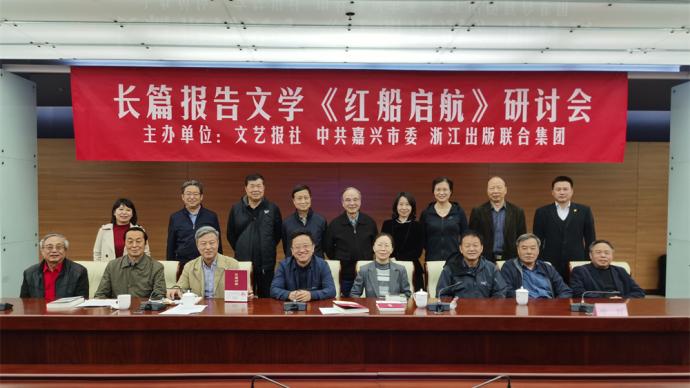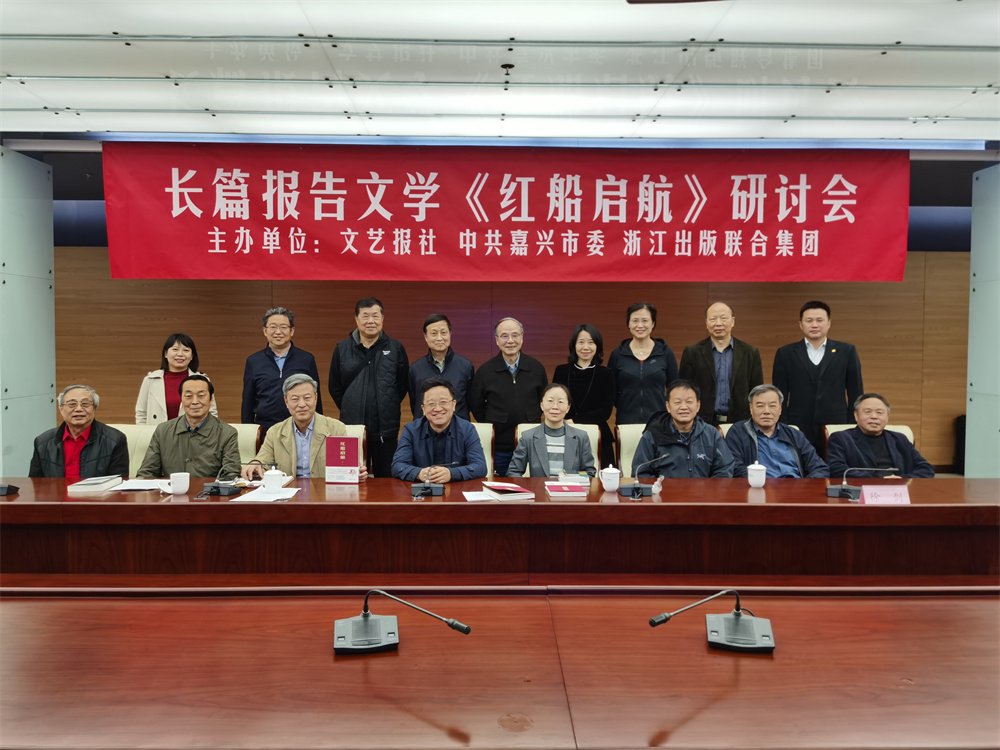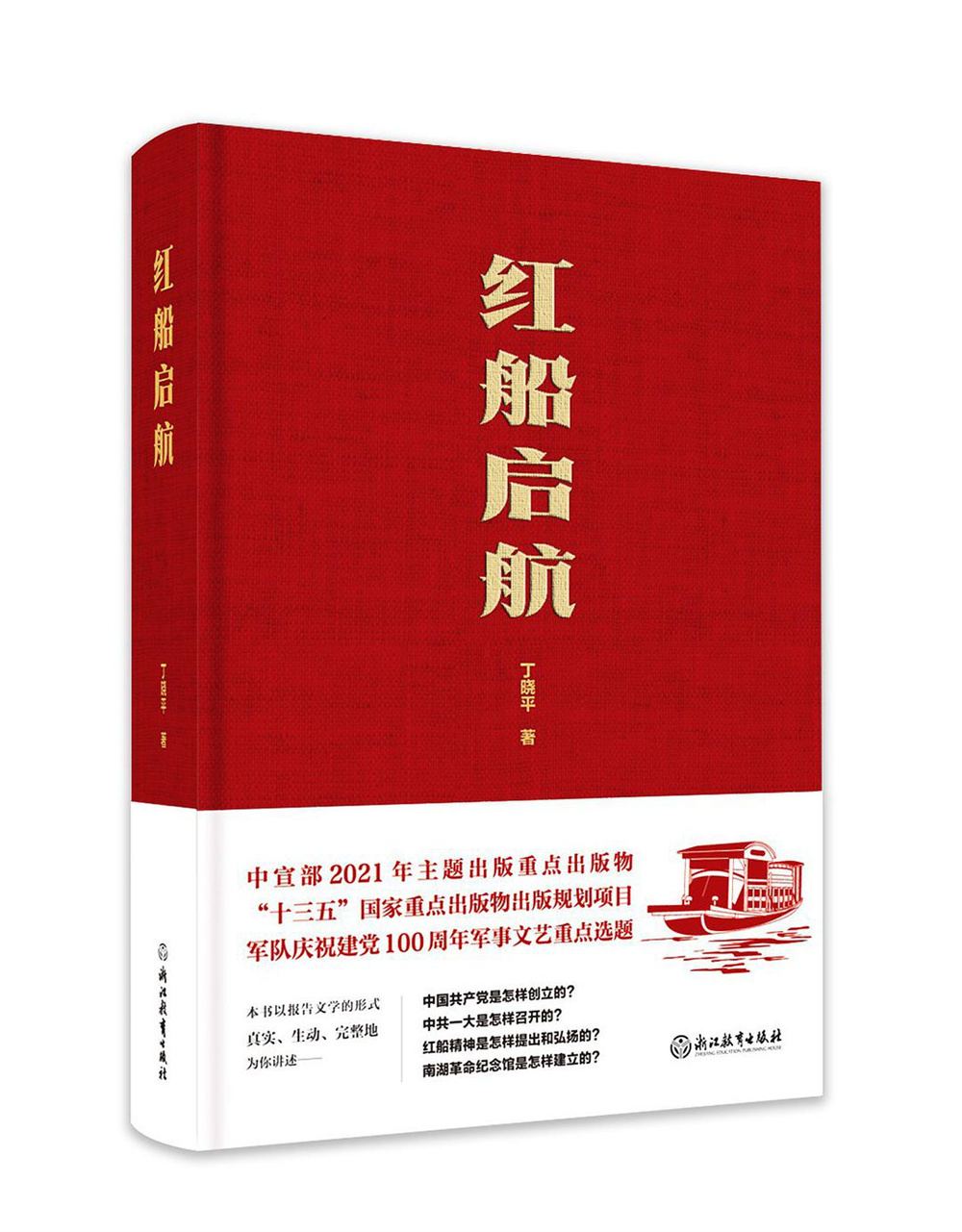
On the morning of April 9, military writer Ding Xiaoping's long reportage "The Red Boat Sails" seminar was held simultaneously in Beijing, Hangzhou and Jiaxing in the form of video link. The seminar was sponsored by Literary News, the Jiaxing Municipal Committee of the Communist Party of China, and Zhejiang Publishing United Group, and hosted by Zhejiang Education Publishing Group, the Publicity Department of the Jiaxing Municipal Committee of the Communist Party of China, and the Jiaxing Federation of Literary and Art Circles. Dozens of experts and scholars attended the meeting online and offline. The meeting was presided over by Liang Hongying, editor-in-chief of the "Literature and Art Newspaper". 

According to Yan Jingming, vice chairman of the Chinese Writers Association, the red boat is a major theme and a popular theme. Ding Xiaoping's "Red Boat Sailing" has distinctive features: first, as far as the red boat is concerned, this book runs through a hundred years of history, not only writing about the red boat in 1921, but also about the red boat in 2021; second, The work not only tells the experiences of important historical figures such as Li Dazhao, Chen Duxiu, Mao Zedong, etc., but also starts from small figures. For example, when writing the first year of the party, from the perspective of Wang Huiwu, the big historical "fan" is gradually opened, so that the story has both The accuracy of party history, and a sense of intimacy and focus. As a literary work, "The Sail of the Red Boat" is highly readable and worthy of serious study. The revelation of the Red Boat spirit never goes out of style.
Bai Ye, president of the China Contemporary Literature Research Association, also believes that "The Red Boat Sails" can stand out from the rich red works. "It is divided into two volumes, the first volume describes the founding of the party, and the second volume describes the establishment and expansion of the Nanhu Revolutionary Memorial Hall and the spirit of the Red Boat, so it is equivalent to extending the historical span for a hundred years through quantitative changes. It's different from ordinary works." In addition, Bai Ye mentioned that Ding Xiaoping is a reportage writer with the quality of a party history expert, and "The Red Boat Sailing" has more effort in the use of materials and figures than other works. It makes readers feel like they have walked into the party history exhibition hall, which is both real and broad.
Ding Xiaoping said that there are thousands of books on the history of the Communist Party of China, most of which are historical materials compiled by scholars and authoritative institutions, with emphasis on documentary, academic, and political aspects. In this case, the history of the party has become a kind of history that "everyone knows but does not fully know". Therefore, he wants to write a literary work with storytelling, readability, and popularity, which not only writes the bones and bones of history, but also writes the flesh and blood of history, and sees people and things and sees the spirit.
Other participants also conducted in-depth discussions on the contemporary value, literary atmosphere, character characteristics, language style and other topics of "The Red Boat Sailing". Experts believe that, as a masterpiece to celebrate the centenary of the founding of the Communist Party, "The Red Boat Sailing", with its unique narrative angle and literary description, in the continuation of history and reality, looks at the past and focuses on the present, so that readers can read many new historical facts. With new discoveries, many new cognitions and new revelations have been obtained.

Symposium on "The Red Boat Sails" (Beijing Main Venue)
"The Red Boat Sails" is a masterpiece of long reportage that spans literature, history and academics, written by military writer Ding Xiaoping after four years. The book is divided into two volumes, "Red Boat Splitting the Waves" and "Spirit Gathering People's Hearts". The first volume vividly describes the spread of Marxism in China since the May 4th Movement, the meeting of "South Chen and Bei Li" to found the party, and the "National Congress" of the Communist Party of China held on Wangzhi Road in Shanghai and Nanhu in Jiaxing, reproducing the difficulties of the founding of the Chinese Communist Party History; the second volume systematically describes the development of the Nanhu Revolutionary Memorial Hall and the imitation process of the Red Boat for the first time, and deeply excavated and recorded the protection, construction and good use of red resources by the Jiaxing people, continued the red bloodline, carried forward the spirit of the Red Boat, and described the common The touching story of FE's new picture scroll. In July last year, "Red Boat Sailing" was launched by Zhejiang Publishing United Group.
Book Cover of "The Red Boat Sails"
According to the publisher, the book has been reprinted several times in a row shortly after its publication, with a print run of more than 130,000 copies. It was selected as the key publication of the Central Propaganda Department in 2021, the "13th Five-Year Plan" national key publication publication planning project, and the key topic of military literature and art for the army to celebrate the 100th anniversary of the founding of the party.According to Yan Jingming, vice chairman of the Chinese Writers Association, the red boat is a major theme and a popular theme. Ding Xiaoping's "Red Boat Sailing" has distinctive features: first, as far as the red boat is concerned, this book runs through a hundred years of history, not only writing about the red boat in 1921, but also about the red boat in 2021; second, The work not only tells the experiences of important historical figures such as Li Dazhao, Chen Duxiu, Mao Zedong, etc., but also starts from small figures. For example, when writing the first year of the party, from the perspective of Wang Huiwu, the big historical "fan" is gradually opened, so that the story has both The accuracy of party history, and a sense of intimacy and focus. As a literary work, "The Sail of the Red Boat" is highly readable and worthy of serious study. The revelation of the Red Boat spirit never goes out of style.
Bai Ye, president of the China Contemporary Literature Research Association, also believes that "The Red Boat Sails" can stand out from the rich red works. "It is divided into two volumes, the first volume describes the founding of the party, and the second volume describes the establishment and expansion of the Nanhu Revolutionary Memorial Hall and the spirit of the Red Boat, so it is equivalent to extending the historical span for a hundred years through quantitative changes. It's different from ordinary works." In addition, Bai Ye mentioned that Ding Xiaoping is a reportage writer with the quality of a party history expert, and "The Red Boat Sailing" has more effort in the use of materials and figures than other works. It makes readers feel like they have walked into the party history exhibition hall, which is both real and broad.
Ding Xiaoping said that there are thousands of books on the history of the Communist Party of China, most of which are historical materials compiled by scholars and authoritative institutions, with emphasis on documentary, academic, and political aspects. In this case, the history of the party has become a kind of history that "everyone knows but does not fully know". Therefore, he wants to write a literary work with storytelling, readability, and popularity, which not only writes the bones and bones of history, but also writes the flesh and blood of history, and sees people and things and sees the spirit.
Other participants also conducted in-depth discussions on the contemporary value, literary atmosphere, character characteristics, language style and other topics of "The Red Boat Sailing". Experts believe that, as a masterpiece to celebrate the centenary of the founding of the Communist Party, "The Red Boat Sailing", with its unique narrative angle and literary description, in the continuation of history and reality, looks at the past and focuses on the present, so that readers can read many new historical facts. With new discoveries, many new cognitions and new revelations have been obtained.
Related Posts